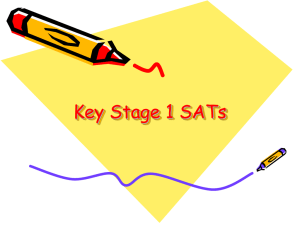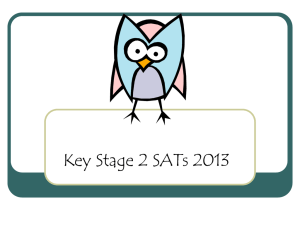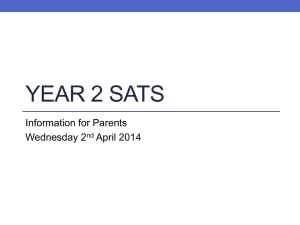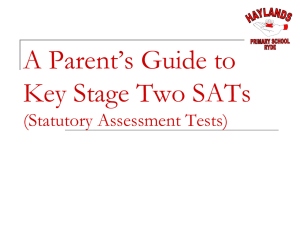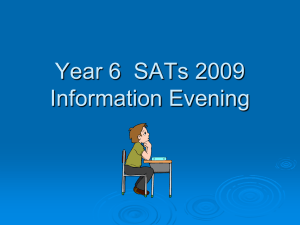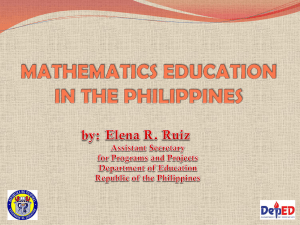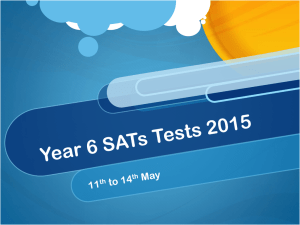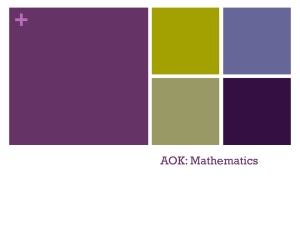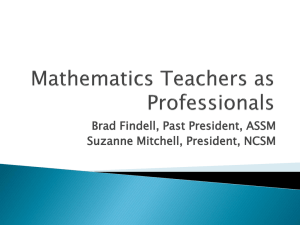Teacher Assessment - Wildmoor Heath School
advertisement
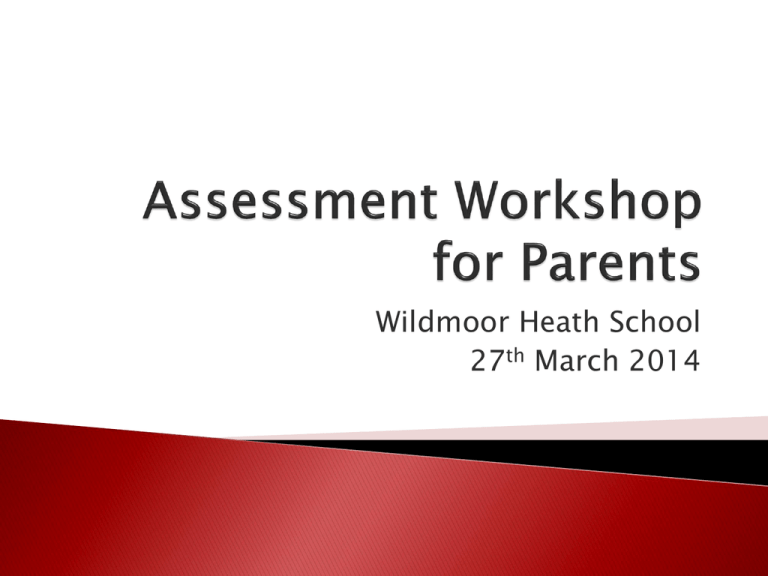
Wildmoor Heath School 27th March 2014 To know about statutory end of phase assessments (and the coming changes) To know about on going assessments in school To look at test materials What skills / knowledge do they have now and what do they need to do next? (Target setting) Have they reached their targets? (Tracking) What do we need to do to get them there? (Interventions) Summative ◦ Statutory assessments at end of EYFS, KS1 and KS2 ◦ Half termly ‘tracking’ - informs intervention planning (RAP groups) ◦ NC levels Formative (Assessment for Learning - AfL) ◦ During and between lessons – informing teaching and planning ◦ AfL techniques include: Talking (learning) partners Effective questioning Learning objectives and success criteria Self and collaborative marking and feedback EYFS Profile End of Year 1 Phonics test End of Key Stage 1 SATs (end of Year 2) End of Key Stage 2 SATs (end of Year 6) Children are assessed against 17 Early Learning Goals 3 Prime areas of learning & 4 specific areas: Prime Areas Specific Areas Communication & Language Literacy Physical Development Mathematics PSED Understanding the world Expressive arts and design Children assessed through observation Learning journeys “Development Matters” Photos Incidental and narrative observations of children in their environment Samples of children's work Parent’s comments and observations Children’s comments Completed in June Teacher assessment – ‘best fit’ Assesses against Early Learning Goals (ELGs) Short narrative describing child’s three learning characteristics Judged as emerging, expected or exceeding Good level of development (GLD) defined as at least expected development in prime areas and mathematics and literacy. Week beginning 16th June 2014 40 words 20 real words 20 pseudo words e.g. spron, jound Specifically tests decoding (AF1) NOT reading as a whole Children that do not achieve required level in Year 1, repeat the test in Year 2 Commonly known as ‘SATs’ Tasks and Tests that the Government sets for children aged 7 & 11 Children's knowledge in English, Mathematics and Science is assessed A mix of tests and teacher assessment depending on the Keystage and subject Key Stage 1 Key Stage 2 (All teacher assessed) (Tests and teacher assessment) Literacy Speaking and listening Reading Writing (including spelling and handwriting) Maths Science English Reading (test) Writing (teacher) Spelling, Grammar & Punctuation (test) Maths (test) Science (teacher) End of Year 2 End of Year 4 End of Year 6 WTL1 Level 1 Below average Level 2c Low average Level 2b National standard Level 2a High average Level 3c Above average Level 3b (Not sub-levelled for SATs) Level 3a Level 4c Below average Below average National standard (Not sub-levelled for SATs) Above average Low average Level 4b National standard Level 4a High average Level 5 Above average Level 6 Well above average The tests help to inform teacher assessment One overall level for each subject reported to parents Carried out as part of normal teaching practice Purpose is to identify next learning steps Reported to parents at each stage of child’s education Normal day One to one, or in small groups Some whole class Children asked to do their best Teachers explain what the children have to do Children must work without adult help 2a - Must be entirely accurate 2b - Can make a mistake on 1 word in 20 2c - Can make a mistake on 1 word in 10 Comprehension booklet 2a in both task & test - children go on to take Level 3 test Two writing tasks One longer - about 45 mins – eg a recount or a story One shorter - about 30 mins, eg an invitation or a postcard Done on different days Spelling test Marks for handwriting Teacher assessment Level 1 Teacher assessment Level 2 or above, then take tests Level 2 or Level 3 test Teacher assessment (no test) 4 attainment targets ◦ ◦ ◦ ◦ Scientific Enquiry Life Processes & Living Things Materials & their Properties Physical Processes Overall Level given Used as a progress measure from KS1–2 ◦ Children expected to make at least ‘2 Levels of progress’ from Year 2 - 6 (e.g. from Level 2 to 4) Published (league tables) ◦ %-age making Level 4+ in each subject ◦ %-age achieving Level 4+ in reading, writing and mathematics combined Allows comparison against other schools Tests the knowledge, skills and understanding that is taught in school daily – no tricks! National timetable spread over a week Week beginning 12th May 2014 Children absent during this week will take the test later Children with SEN – reader or scribe Date Level 3-5 Tests Level 6 Tests Monday 12th May English reading test English reading test Tuesday 13th May English grammar, punctuation and spelling test English grammar, punctuation and spelling test Wednesday 14th May Mental mathematics test Mathematics – Test A Thursday 15th May Mathematics – Test B Mathematics – Paper 1 Mathematics – Paper 2 English spelling, punctuation and grammar (SPAG) test SPAG test informs writing assessment Writing –teacher assessment only (based on work done in class over time) Moderated by local authority team Test Changes made for 2014 Three different text types, no connecting theme (easiest first, hardest last) 60 minutes to read and answer questions Children can approach paper as they wish (i.e. read one text and answer questions before moving on to next text) Different sorts of comprehension questions Externally marked Two papers – calculators can’t be used in either Mental mathematics test Practise questions (technique) Mock week Revision Intervention (booster) groups in and after school Attendance every day & on time Avoid taking holidays during term time Enough sleep ensures they are alert & ready to learn Attend parents evenings Encourage positive attitudes to school & learning Encourage them to have a go, not worry if they make a mistake Ensures ‘no child left behind’ Summative assessment made each half term for reading, writing and mathematics ◦ Are they at, above or below age related expectations (ARE)? ◦ Are they making progress (from previous July and entry to phase)? ◦ Pupil progress meetings identify children needing extra support or challenge ◦ Interventions planned and evaluated (RAPs) Any practice which provides information to teachers (and pupils) about what the children need to do to improve Allows teachers to adapt lessons ‘in action’ to better challenge and support children Based on both academic (Black & Wiliam, 1998) & classroom based action research (Shirley Clarke, 2001-14) ◦ Talk (learning) partners ◦ Effective questions ◦ Marking and feedback – highlighting and ‘closing the gap’ comments ◦ Learning objectives and success criteria Participation from all children (not just those with their hands up) Time to think, formulate ideas and responses Teachers ‘listen in’ and take feedback to collect information Randomly chosen partners – mixed attainment groupings Changed every 2 weeks Talking partner rules established Demands explanation Promotes discussion and explanation Reveals misconceptions and understanding Develops critical thinking, reasoning and problem solving skills (NB. Bloom’s Taxonomy) Gives pupils confidence in expressing their opinions Stimulates curiosity and interest Reinforces previous learning Develops respect for other points of view Close to when the work is done (often during or shortly after the lesson) Includes ‘formal’ marking, self and collaborative marking and verbal feedback Focussed on the learning objective and success criteria Marking highlights success and what needs to be improved Comments help to ‘close the gap’ Children have time to make improvements immediately Children know what they are learning each lesson Children know what success ‘looks like’ and what to do / include to be successful: ◦ Modelling & ‘excellent’ examples ◦ Compulsory ◦ Optional Marking and feedback given using LO and SC New NC starts in September 2014 Current Year 5 and 6 tested on ‘old’ curriculum – SATs used as now Current Year 4 and below will be tested on ‘new’ curriculum when they reach Year 6 – govt. yet to announce how and which subjects End of KS1 assessment will still be ‘teacher’ rather ‘test’ Existing assessment framework - NC Levels (Level 4, Level 2b etc) scrapped from September 2014 - up to schools what they do! Children will be assessed as ‘Secondary ready’, ‘KS2 ready’, ‘KS1 ready’ Proposals that children are ranked by test score and parents told which percentile their child is in compared to school / national What are your questions? Chance to look at the materials
